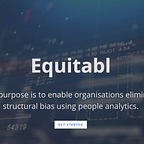The #IWD campaign theme for 2023 is all about embracing equity, which gives people a chance to think about our current environment and how equal opportunities are given for everyone. Do we recognise and acknowledge that inequity exists? Do we understand that equity is different from equality? If we come across unfair practices at workplace or anywhere else, how can we address this? What’s the constructive way to solve for this problem?
Equity is a HUGE problem to solve for. And it cannot be done by one framework, or a solution or a product. It starts differently for different people. You do you :) but the logical place for us to start with, is by building awareness of what means what, before finding a solution for it. On this year’s International Women’s Day, let’s get our facts straight.
With so many countries passing legislations to make organisations disclose their pay gap report, and with many companies proactively doing this anyway — people often tend to use the terms ‘pay gap’ and ‘pay inequality’ interchangeably. In fact, those two terms mean two completely different things that reflects on the organisations values and principles. Unless we understand the fundamental differences between the two, it might be considerably challenging to close the pay gap in organisations.
So, what do these terminologies mean and how are they both different?
Consider the following structure of a fictional consulting company with 15 men and 15 women working in them. The hierarchy starts with Consultants at the bottom, followed by Senior consultants, managers, associate directors, directors and partners at the top.
Note that at the particular job level (ex: consultants), both men and women are paid the same hourly rate of $50. The same goes for other job levels where, as you can see, men and women are paid equally for the same roles. In a scenario where men are paid $40 and women are paid $50 for the role ‘consultant’ – then we are looking at ‘pay inequality’ issue at this fictional consulting company. To be precise, we’d calculate that on average, women are paid 25% more than men for that role. Now, consider a scenario where for all job levels, the 15 women are paid 25% more than the 15 men. Just by looking at the pay difference from this cut, it appears that women are paid higher than men in this company. This is considered illegal in many countries where one group is paid higher than the other group for the same role. Unless this fictional organisation can justify that all women were working overtime with extra hours, or that they are skilled than their counterparts or the job descriptions are different even though they are grouped under the same role etc. this organisation is breaking law in countries protected by equal pay legislations. Now this is the issue of Pay Inequality, not pay gap.
As illustrated in the image above, on an average the 15 men in the company are paid $171 per hour whereas the 15 women in the company are paid $142 per hour. The average man earns 18.5% higher than the average women in this fictional organisation. The Gender Pay gap in this scenario is represented by indicating that for every $1 that a man earns, the women earns $0.83 — but it is worthwhile to note that this (averages) is not the only way to calculate the gender pay gap. In fact, there is no ONE correct way to represent gender pay gap.
One of the other methods to represent gender pay gap at the company is by looking at median. In this ideal equal pay scenario, the median man is a manager and the median woman is a Senior Consultant.
What does this image tell us? There is a representation gap when the median man is a manager and a median woman is a Senior Consultant — Meaning that men are more likely to be Directors and Partners whereas women are more likely to be consultants.
In a nutshell, the difference in pay between a man and a woman doing the same job implies pay inequality. However, in order to actually close the gender pay gap, this fictional company needs to replace low paid women in a role with low paid men, and high paid men in a role with high paid women, enough times, until the gap is closed. This should be done on top of ensuring there is pay equality at all levels.
For purposes of illustration, this article has used ‘gender’ as a factor for distinction, however, the similar principles can be applied for closing racial, ethnic, generational pay gaps too! Keep in mind that these analysis considers there are equal number of men and women, however to close racial and ethnic gaps, the fact that majority and minority population varies needs to be taken into account.
